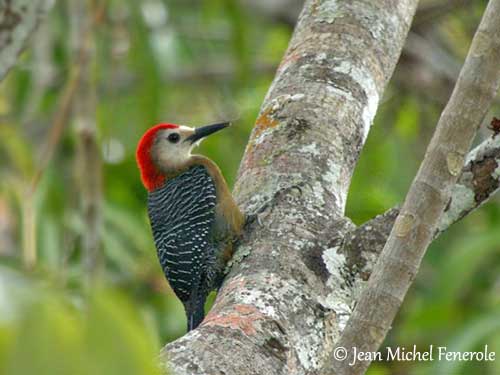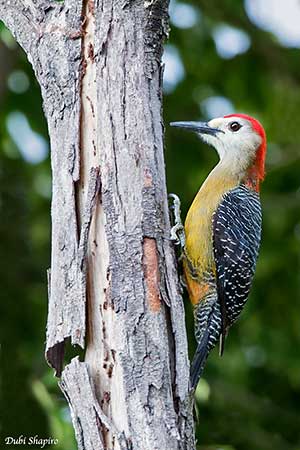
Fr: Pic de la Jamaïque
Ang: Jamaican Woodpecker
All: Jamaikaspecht
Esp: Carpintero Jamaicano
Ita: Picchio della Giamaica
Nd: Jamaicaspecht
Sd: jamaicaspett
Photographers:
Jean Michel Fenerole
Photos d’Oiseaux du monde
Ken Havard
My Bird Gallery & Flickr gallery 1 & Flickr gallery 2
Dubi Shapiro
Dubi Shapiro Photo Galleries
Text by Nicole Bouglouan
Sources:
HANDBOOK OF THE BIRDS OF THE WORLD Vol. 7 by Josep del Hoyo-Andrew Elliott-Jordi Sargatal – Lynx Edicions – ISBN: 8487334377
BIRDS OF THE WEST INDIES – by Herbert Raffaele, Kristin Williams et Tracy Pedersen – Helm – ISBN: 9780713649055
Woodpeckers of the World: The Complete Guide by Gerard Gorman – Editeur: A&C Black, 2014 – Helm Photographic Guides - ISBN: 1408147173, 9781408147177
WOODPECKERS, an identification guide of the woodpeckers of the world by Winkler Hans and Christie David – Helm – ISBN: 0395720435
Neotropical Birds – Cornell Lab of Ornithology
Wikipedia, the free encyclopaedia
Jamaican Woodpecker
Melanerpes radiolatus
Piciformes Order – Picidae Family
INTRODUCTION:
The Jamaican Woodpecker is endemic to Jamaica where it frequents a variety of woodlands both in mountains and in lowlands, including forests and plantations, but also rural and urban gardens. It may occur up to 1,800 metres of elevation.
It feeds on fruits, nectar, insects, snails and lizards found while foraging in trees, vines and bromeliads. It typically nests in tree hole and 2-3 broods are raised in one year.
The Jamaican Woodpecker has restricted range and is vulnerable to habitat destruction. However, this species is currently common and not globally threatened.
DESCRIPTION OF THE BIRD:
Biometrics:
Length: 24-26 cm
Weight: 92-130 g
The Jamaican Woodpecker adult male has black upperparts narrowly barred white (sometimes with greenish tinge), including upperwing-coverts and tertials. Rump and uppertail-coverts show broader bars.
On the upperwing, the flight-feathers are black, with browner primaries and narrow white bars on both webs of outer primaries.
The uppertail is black but the central pair of rectrices is narrowly barred white on inner webs, whereas the outer pairs show small white spots or bars on outer webs.

The underparts are olive-grey to brownish from breast, but there is a yellow/reddish tinge on central belly. The area from lower flanks to undertail-coverts is black with whitish bars. The underwing is brownish-black with white barring. The undertail is more brownish than the uppertail, with outer rectrices washed olive.
On the head, the forehead is whitish to buff. Forecrown to hindneck is red. Lores are yellowish. The rear ear-coverts are greyish to olive. Rest of head including face, chin, throat and uppermost breast is white.
The long, black bill has curved culmen. The eyes are red, surrounded by grey/brown orbital skin. Legs and feet are dark grey.
The adult female is slightly smaller than male. She has grey to dark grey crown, sometimes tinged buff or partly black. The red area extends only from hindcrown to hindneck.
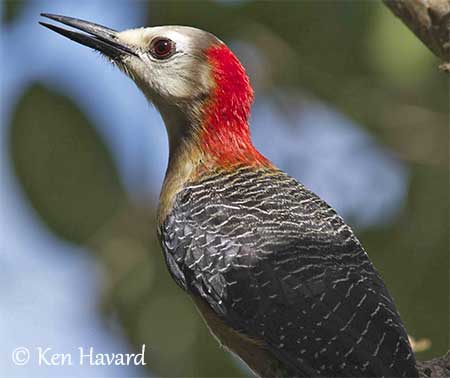
The juvenile is duller, with greyer underparts and yellower central belly. The bars are less conspicuous on flanks.
The eyes are brown (not red). Both young male and female have red on crown, but less extensive on female.
RANGE:
The Jamaican Woodpecker is endemic to Jamaica where it is common and resident.
HABITAT:
The Jamaican Woodpecker frequents a wide variety of open and closed wooded areas from lowlands to mountains, including humid and dry mountain forests and lowland plantations of coffee, coconut and citrus, palm groves, mangroves, pastures and farmland with trees, and also gardens in both rural and urban areas.
The species is visible from sea-level up to 1,800 metres of elevation.
CALLS AND SONGS: SOUNDS BY XENO-CANTO
During the breeding season, both male and female drum loudly and perform mutual tapping close to the nest entrance. Both mates also produce contact calls described as “krirr, krirr” or “whirr-whirr”.
The most frequent call of the Jamaican Woodpecker is a loud “kaaa” usually repeated 2-3 times. When alarmed, they give “kao” calls that can become a scold if threatened. The advertising call is a very loud “kaaaah”.
We can also hear a squawking, grating “chee-ee-urp”, a “weecha-weecha” during the displays, and a faster “churp-churp-churp” given in series or as separate notes.
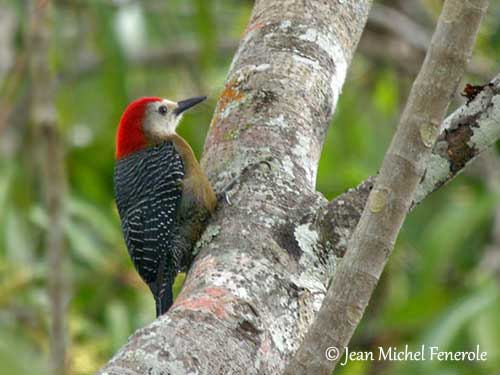
BEHAVIOUR IN THE WILD:
The Jamaican Woodpecker feeds on insects including Orthoptera, Lepidoptera and Coleoptera that are the main part of animal prey. It also takes snails and sometimes lizards (Anolis).
This species also consumes fruits of Cecropia, Ficus and Daphnopsis, and nectar from flowering trees.
It forages in mid and upper levels of trees and hunts singly or in pairs. It searches for prey in bromeliads and other epiphytes, on wood surfaces, in crevices and debris. It also pecks at sugar canes to get the juice.
The main feeding behaviour includes snatching fruits, and probing followed by pecking, gleaning and also flycatching from treetops.
Both mates drum during the breeding season. In addition to the usual rhythmic rolls, they also perform slower series of tapping near the nest hole.
Some displays include mutual bill-waving, tail spreading, crest rising while the head swings from side to side. They are monogamous and solitary nesters. They nest in holes excavated in tree trunk or branches by both adults, but the male does most of this work.
The Jamaican Woodpecker is resident in Jamaica. It has the typical undulating flight of the Picidae.
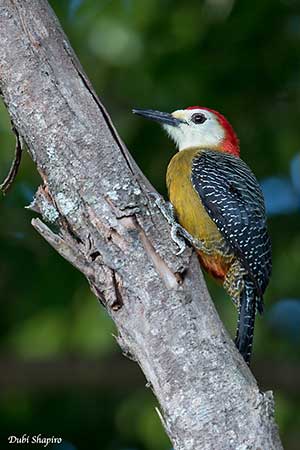
REPRODUCTION OF THIS SPECIES:
The breeding season occurs between December and August and sometimes in other months too. The laying takes place from January to early July, and this species may produce 2-3 broods per season.
The Jamaican Woodpecker excavates a hole in tree trunk or branch between 5 and 15 metres above the ground, and sometimes in utility pole. The male does most of the work. They defend an area of about 40 metres around the nest-site.
The female lays 3-5 white eggs at daily intervals. The incubation lasts 13 days, shared by both adults. The chicks are brooded and fed by both parents, but the female feeds them more often than the male.
The young fledge one month after hatching and they remain in family group for at least one month more.
The breeding success may be affected by competition for nest-holes with the Common Starling.
PROTECTION / THREATS / STATUS:
The Jamaican Woodpecker has restricted range but it is described as “common” throughout the island.
The species is mainly threatened by habitat loss, but many forests are now protected. However, this problem involves some local declines.
But currently, the Jamaican Woodpecker is not globally threatened and evaluated as Least Concern.
